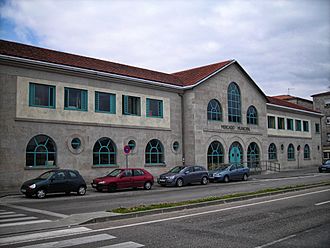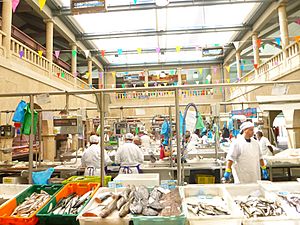Mercado central de Pontevedra facts for kids
Quick facts for kids Central Market of Pontevedra |
|
|---|---|
|
Mercado de Abastos de Pontevedra
|
|

North façade of the market
|
|
| General information | |
| Type | Covered Market |
| Location | Pontevedra, Galicia, Spain |
| Coordinates | 42°26′03.3″N 8°38′37.1″W / 42.434250°N 8.643639°W |
| Construction started | 1945 |
| Completed | 1948 |
| Opening | 20 January 1948 |
| Owner | City Council of Pontevedra |
| Technical details | |
| Floor count | 2 |
| Design and construction | |
| Architect | Emilio Quiroga Losada |
The Central Market of Pontevedra is a big covered market in Pontevedra, Spain. It is also called the Municipal Market of Pontevedra. You can find it at the edge of the historic centre, near the Burgo Bridge. The market looks out over the Lérez River. It first opened its doors in 1948.
Contents
History of the Market
For a very long time, since the Middle Ages, people sold their goods in the medieval squares of Pontevedra.
- In Plaza de Teucro, you could buy bread and milk.
- In Plaza de la Verdura, people sold vegetables, fruit, chestnuts, and fish.
- In Plaza de Méndez Núñez, chickens were sold, among other things.
First Covered Market
By the 1880s, Pontevedra needed a better place to sell food. A covered market would be much more comfortable and cleaner. The city decided to build one in 1884.
The first covered market was designed by architect Alejandro Sesmero. It opened on 15 August 1886. This market was built next to the Burgo Bridge, where an old prison used to be. It had a ground floor and faced the Lérez River. Inside, there were marble counters and iron fans for meat. A mix of iron and wood covered the market.
Building the New Market
The first covered market was taken down in the 1940s. The city wanted a new, bigger market. This new market was built on Sierra Street, where an old slaughterhouse stood.
Architects Emilio Quiroga Losada and José Barreiro Vázquez designed the new market in 1942. Construction started in 1945. While the new market was being built, sellers used temporary stalls. These were set up near the Burgo Bridge.
The new market had two floors and was designed by Emilio Quiroga Losada. It officially opened on 20 January 1948.
Modern Renovations
By the 1990s, the 1948 market needed a big update. It had to meet new needs. In 1999, a temporary market was built across the Lérez River. This was near the city's sports pavilion.
Then, in 2000, the 1948 market was carefully taken apart, stone by stone. It was rebuilt on the same spot on Sierra Street. Architect César Portela led this renovation. The completely new and improved market opened on 10 October 2003. The renovation made the market feel more spacious and bright. It also added a two-floor underground car park.
Recent Updates
In 2019, the first floor of the market was changed. It became a special food area called Gastroespazo. This area opened on 22 August 2019. It has different food stands. You can find hake, octopus, mussels, chicken, and traditional Galician food there.
In October 2020, the market started selling its products online. You can visit their website, ponteabastos.com, to buy things.
What the Market Looks Like
The Central Market is a two-story building made of granite. It has a rectangular shape and a traditional Galician style. You will see columns, arches, and arcades.
Outside the Market
The market's main front has three large arches on the ground floor. These are the entrances to the building. On each side, there are five more arches with small shops.
On the upper floor, the middle part has three big, rounded windows. The one in the centre is the largest. On each side, there are rectangular windows with balconies. The very top of the central part has triangular shapes called pediments.
The north side of the market also has three rounded windows. Between them, you can see four small, round windows.
Inside the Market
When you enter the market, you will see a large stone staircase. This staircase leads up to the first floor. The main staircase ends in a balcony on the first floor. Below it, there is a passage with three arches. These arches help you move towards the market stalls.
Inside, the market has two large open areas in the middle. These courtyards have balconies on the first floor. On the ground floor, they have arcades.
Stalls and Products
In 2014, the market had 367 places to sell things. After the first floor became the Gastroespazo in 2019, there are now 214 stalls. These stalls sell fresh fish, seafood, fruit, and vegetables. There are also 30 indoor stalls that mainly sell meat. Outside, under the arcades, there are 19 stalls. They sell things like clothing, newspapers, or jewellery. You can also find flower sellers on the ground floor.
The market is also home to the Pontevedra fish auction. This is where fish and seafood are sold to buyers.
Since 2002, the market has an underground car park. It has two floors and 208 parking spaces. This car park is also useful for people visiting the historic city centre.
Culture and Art
During the market's renovation, something interesting was found nearby on Sierra Street. Workers discovered parts of the medieval city walls. These walls once protected the city long ago.
On 25 November 2009, a special sculpture was placed in front of the market. It is called "A moza das galiñas" (The girl with the chickens). The artist, Cuqui Piñeiro, created it. The sculpture shows a woman feeding four hens and a rooster. This artwork honours the women of Galicia and the market's sellers.
Gallery
Annexes
Related articles
- Caixa de Pontevedra
- Burgo Bridge
See also
 In Spanish: Mercado de Abastos de Pontevedra para niños
In Spanish: Mercado de Abastos de Pontevedra para niños

















